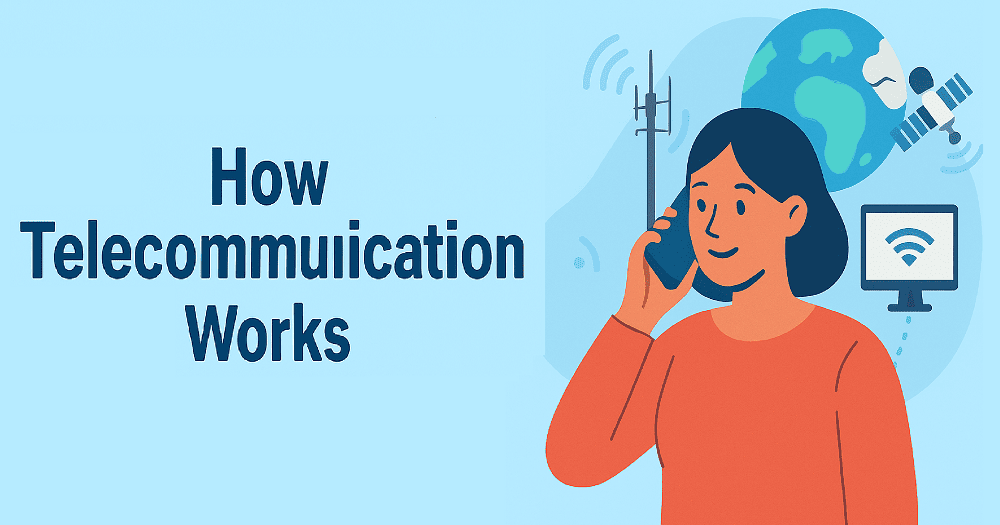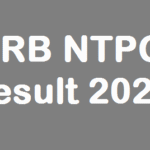How Telecommunication Works — A Simple, Complete Guide
From your voice to bits to light beams and radio waves—here’s the end‑to‑end journey that connects people, places, and machines worldwide.
📡 What is Telecommunication?
Telecommunication is the exchange of information—voice, text, images, or video—over distance using electronic systems. A basic flow looks like: Source → Transmitter → Medium → Receiver → Destination.
In plain words: Your phone turns sound into digital signals, sends them through cables or the air, and another phone turns those signals back into sound.
🛠️ Core Building Blocks
1) Transmitter (Sender)
Converts information (e.g., your voice) into an electrical or digital signal. In phones, the microphone and codec handle this step.
2) Transmission Medium
- Copper (twisted pair/coax): affordable, short‑to‑medium distances.
- Fiber optic: uses light for ultra‑high speed and long distances.
- Radio/Microwave: wireless links via cell towers or point‑to‑point radios.
- Satellite: global coverage, great for remote areas and broadcast.
3) Receiver
Turns the incoming signal back into usable information—audio for calls, frames for video, or packets for apps.
📞 How a Phone Call Works (Step‑by‑Step)
- Voice → Digital: Your speech is sampled and encoded (e.g., with a voice codec).
- Access: Your handset connects to a cell tower (mobile) or a router (VoIP/Wi‑Fi).
- Transport: Signals travel through fiber, microwave backhaul, or the public internet.
- Routing & Switching: Network elements choose a fast, reliable path in milliseconds.
- Digital → Voice: The other device decodes the audio so the listener hears you almost instantly.
🌐 Wired vs Wireless vs Satellite
Wired
- Fiber: high bandwidth, low loss, long reach.
- Copper: cheaper, widely deployed, but slower over distance.
Wireless
- Cellular (4G/5G): mobility + broadband.
- Wi‑Fi: local high‑speed access in homes/offices.
- Microwave: line‑of‑sight backhaul links.
Satellite
Ground stations (and user terminals) beam signals to orbiting satellites, which relay them back to other locations. Ideal for remote regions and broadcast TV; new LEO constellations also offer broadband internet.
⚡ Why Modern Telecom Feels So Fast
- Digital packets: data is split and sent in parallel; missing pieces are retransmitted.
- High‑capacity media: fiber and 5G deliver multi‑Gbps speeds.
- Smart networks: switching, QoS, and caching reduce delays.
- Edge computing: processing closer to users for lower latency.
🔮 What’s Next: 5G, IoT, AI & Satellites
- 5G & 5G‑Advanced: ultra‑low latency, network slicing, private 5G for factories/campuses.
- IoT: billions of sensors and devices exchanging data automatically.
- AI‑driven networks: predictive maintenance and automated optimization.
- LEO satellite internet: near‑global broadband coverage.
🧭 Mini Glossary
- Bandwidth: maximum data rate a link can carry.
- Latency: time delay between sending and receiving.
- Backhaul: links that connect cell towers to the core network.
- Codec: software/hardware that compresses and decompresses audio/video.
- Packet: a chunk of data with headers for delivery.
❓ FAQ
What is the difference between 4G and 5G?
5G offers far higher speeds, much lower latency, and supports many more devices per area than 4G. It also enables features like network slicing for specialized services.
Why does my call sometimes lag?
Lag (latency) can come from network congestion, weak signal, long distances (e.g., satellites), or packet loss requiring retransmission.
Is fiber better than copper?
For speed and distance, yes. Fiber has lower loss and far higher capacity, though copper remains cost‑effective for short runs.
What is VoIP?
Voice over Internet Protocol sends calls as data packets over IP networks instead of dedicated voice lines, enabling features like HD voice and easy scaling.
👍 Was this helpful?
Share this guide or reach out for a customized version for your website or training materials.



























